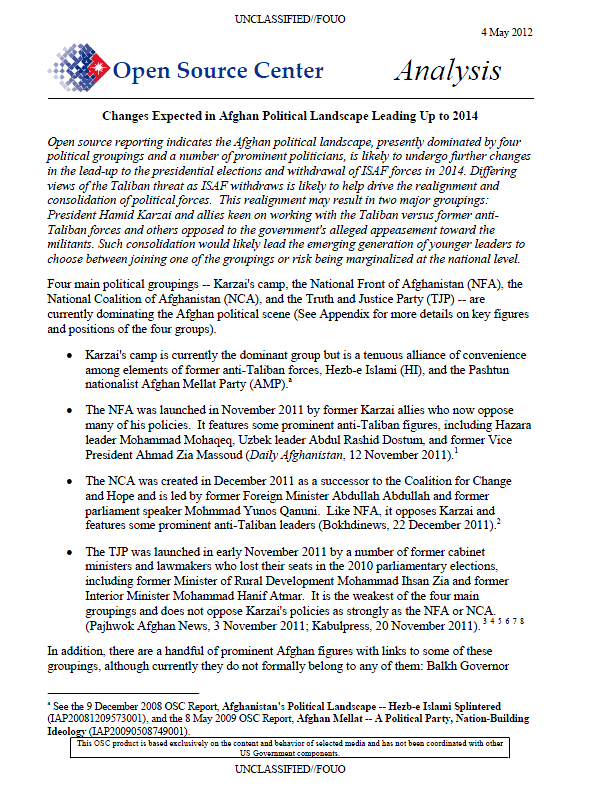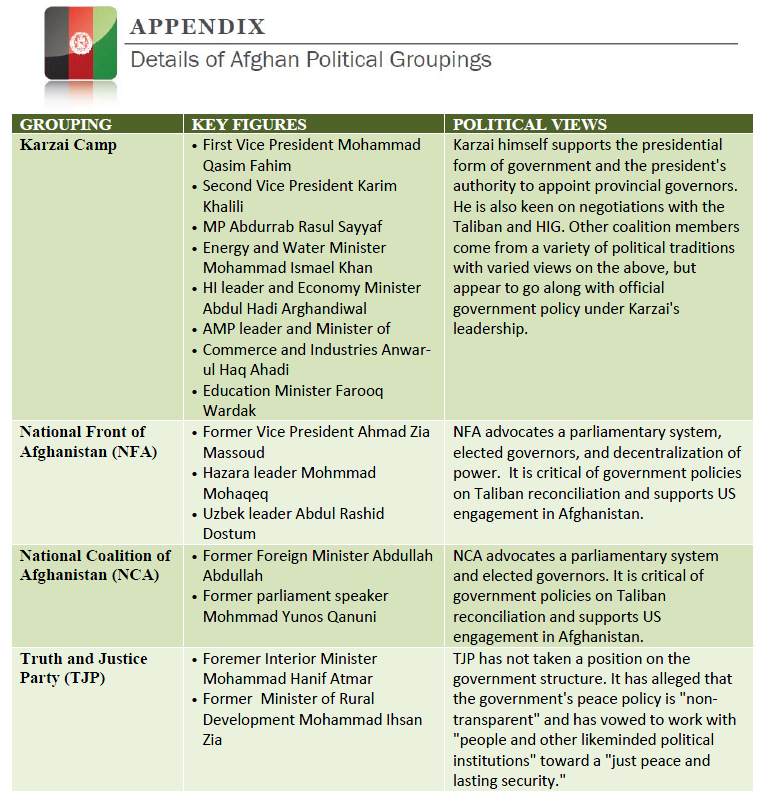Open Source Center Analysis: Changes Expected in Afghan Political Landscape Leading Up to 2014
- 9 pages
- For Official Use Only
- May 4, 2012
Open source reporting indicates the Afghan political landscape, presently dominated by four political groupings and a number of prominent politicians, is likely to undergo further changes in the lead-up to the presidential elections and withdrawal of ISAF forces in 2014. Differing views of the Taliban threat as ISAF withdraws is likely to help drive the realignment and consolidation of political forces. This realignment may result in two major groupings: President Hamid Karzai and allies keen on working with the Taliban versus former anti-Taliban forces and others opposed to the government’s alleged appeasement toward the militants. Such consolidation would likely lead the emerging generation of younger leaders to choose between joining one of the groupings or risk being marginalized at the national level. Four main political groupings — Karzai’s camp, the National Front of Afghanistan (NFA), the National Coalition of Afghanistan (NCA), and the Truth and Justice Party (TJP) — are currently dominating the Afghan political scene (See Appendix for more details on key figures and positions of the four groups).
- Karzai’s camp is currently the dominant group but is a tenuous alliance of convenience among elements of former anti-Taliban forces, Hezb-e Islami (HI), and the Pashtun nationalist Afghan Mellat Party (AMP).
- The NFA was launched in November 2011 by former Karzai allies who now oppose many of his policies. It features some prominent anti-Taliban figures, including Hazara leader Mohammad Mohaqeq, Uzbek leader Abdul Rashid Dostum, and former Vice President Ahmad Zia Massoud (Daily Afghanistan, 12 November 2011).
- The NCA was created in December 2011 as a successor to the Coalition for Change and Hope and is led by former Foreign Minister Abdullah Abdullah and former parliament speaker Mohmmad Yunos Qanuni. Like NFA, it opposes Karzai and features some prominent anti-Taliban leaders (Bokhdinews, 22 December 2011).
- The TJP was launched in early November 2011 by a number of former cabinet ministers and lawmakers who lost their seats in the 2010 parliamentary elections, including former Minister of Rural Development Mohammad Ihsan Zia and former Interior Minister Mohammad Hanif Atmar. It is the weakest of the four main groupings and does not oppose Karzai’s policies as strongly as the NFA or NCA. (Pajhwok Afghan News, 3 November 2011; Kabulpress, 20 November 2011).
In addition, there are a handful of prominent Afghan figures with links to some of these groupings, although currently they do not formally belong to any of them: Balkh Governor, Atta Mohammad Nur, Nangarhar Governor Gol Agha Sherzai, former intelligence chief Amrullah Saleh, Badakhshan MP Fawzia Koofi, Kabul MP Ramazan Bashardost, and Nangarhar MP Abdul Zaher Qadir.
…
Growing concerns about the Taliban threat and its role in post-2014 Afghanistan may consolidate the political landscape around two political, and possibly even militarized, rival clusters.
- A merger of the NFA and NCA at some point before or during 2014 is possible, given their similar political agendas and common anti-Taliban roots. Both groups have called for parliamentary government and elected governors and are suspicious of reconciliation with the Taliban. The differences between them seem to be mainly of a personal nature at the leadership level. Massoud indicated recently that NFA and NCA would “merge soon” to which Abdullah responded by saying that NCA “have not yet decided on merger with [NFA]” (Bokhdinews, 17, 20 January). NCA might pursue the idea of merger more favorably after Abdullah’s rotating leadership ends, since Qanuni has expressed desire for a “grand national umbrella” to confront the looming Taliban threat (Jomhornews, 1 April).
- In an 11 March gathering, former anti-Taliban leaders from a cross-section of the major political clusters, including Karzai’s camp, urged unity and even military preparedness among the anti-Taliban forces. Karzai ally MP Abdurrab Rasul Sayyaf said: “Be very careful that we should not be undermined from within under the divisive pretexts of ethnicity, region, and language; we should preserve this united body at any cost.” He warned the anti-Taliban forces not to “sit unconcerned about the future; do not be totally oblivious and unaware about today and post-2014 and thereabouts.” (Tolonews, 11 March). Massoud suggested that the anti-Taliban forces should revive their “military structures” in anticipation of ISAF withdrawal (Jabha-e Melli, 12 March).
Should the NFA and NCA unify and attract major anti-Taliban leaders among Karzai’s allies, the remainder of the Karzai camp may rely increasingly on HI and some level of cooperation even from the Taliban to remain politically relevant.
- In the context of his remarks to deny reports that the insurgent group Hezb-e Islami Gulbuddin (HIG) had severed negotiations with the government, HIG chief negotiator Ghairat Bahir effectively endorsed Karzai’s leadership by saying that “from our perspective Hamid Karzai is the president of Afghanistan” (Bokhdinews, 29 January).
- Similarly, the Afghan Government’s backing of the Taliban’s opening of an office in Qatar and the Afghan ambassador to Pakistan’s suggestive remarks, in a 3 April interview with UK’s Guardian newspaper, that negotiations would lead to the Taliban’s participation in presidential elections suggests that at least some in Karzai’s camp may be willing to court the militants to countervail the anti-Taliban forces’ influence (Hewad, 7 April; Hasht-e Sobh, 8, 9 April).
- State-run newspaper Hewad issued a strongly worded editorial against a 5 May 2011 opposition rally and approvingly quoted a former Taliban leader’s denunciatory words, perhaps portending the dichotomization of politics along pro- and anti-Taliban lines (7 May 2011).
…


